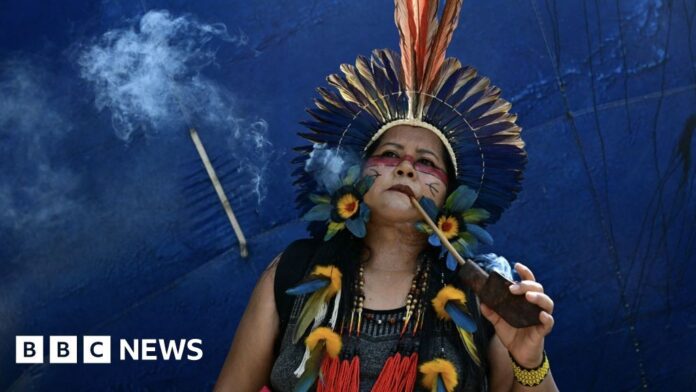Brazil has designated ten new Indigenous territories, a move coinciding with protests at the COP30 climate summit. The expansion aims to protect the culture and environment of these areas, though enforcement remains a challenge. This action marks a reversal from the previous administration and a commitment to land rights under President Luiz Inácio Lula da Silva.
Indigenous Rights and COP30
The new designations follow similar actions taken by Lula’s government, which recognized eleven territories last year. Dinamam Tuxu of the Articulation of Indigenous Peoples of Brazil (APIB) celebrated the move, stating that each territory is “a reason to celebrate.” Despite the recognition, Indigenous groups have faced barriers to participation at COP30, with many lacking accreditation despite the summit hosting the highest number of Indigenous representatives to date. Kleber Karipuna of APIB noted that at least 900 Indigenous people are now inside the summit to negotiate and represent their communities.
Security Concerns and Dissent
The increased security presence at COP30, including armed soldiers and police, has drawn criticism from over 200 human rights groups. These groups argue that the militarized response to protests contributes to a global trend of silencing dissent and marginalizing defenders of land and the environment. Protesters, including Indigenous groups, have clashed with security forces, carrying signs that read “our forests are not for sale.”
Environmental Impact and Deforestation
The expansion of Indigenous territories could prevent up to 20% of additional deforestation and reduce carbon emissions by 26% by 2030, according to a study by APIB, the Amazon Environmental Research Institute, and the Indigenous Climate Change Committee. The new protected areas span hundreds of thousands of hectares and are inhabited by thousands of people from various Indigenous groups, including the Mura, Tupinambá de Olivença, Pataxó, Guarani-Kaiowá, Munduruku, Pankará, and Guarani-Mbya. One area overlaps significantly with the Amazon National Park, a vital part of the rainforest that regulates the global climate and stores carbon.
Historical Context and Policy Shift
Under the previous far-right administration of Jair Bolsonaro, protections for Indigenous lands were frequently unenforced, and mining on these lands was promoted. Lula’s government has taken action to drive out illegal miners from Indigenous territories, reversing the previous policy. Currently, Indigenous lands encompass 117.4 million hectares, roughly 13.8% of Brazil’s territory.
Global Climate Implications
The Amazon rainforest is already at risk of renewed deforestation, threatening its role in carbon sequestration. The expansion of Indigenous territories is seen as a critical step in preserving this vital ecosystem. Countries at COP30 are striving to limit global average temperature rises to 1.5C above pre-industrial levels, as warned by the UN’s Intergovernmental Panel on Climate Change (IPCC), which states that warming of 2C or more would bring serious consequences, including extreme heat, higher sea levels, and threats to food security.
The recognition of Indigenous land rights is not merely a domestic policy shift; it is a crucial element in global efforts to combat climate change and preserve biodiversity.





























